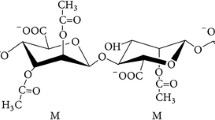Abstract.
Alginate, a copolymer of β-D-mannuronic acid and α-L-guluronic acid and currently commercially produced from the marine brown algae, can also be biologically produced by bacteria such as Azotobacter vinelandii, A. chroococcum and several species of Pseudomonas. The ever-increasing applications of this polymer in the food and pharmaceutical sectors have led to continuing research interest aimed at better understanding the metabolic pathways, the physiological or biological function of this polymer, the regulation of its formation and composition, and optimising the microbial production process. These aspects are reviewed here, with particular attention to alginate formation in the soil bacterium A. vinelandii. In addition, the biotechnological and industrial applications of alginate are summarised.
Similar content being viewed by others
Author information
Authors and Affiliations
Additional information
Received revision: 20 April 2001
Electronic Publication
Rights and permissions
About this article
Cite this article
Sabra, .W., Zeng, .AP. & Deckwer, .WD. Bacterial alginate: physiology, product quality and process aspects. Appl Microbiol Biotechnol 56, 315–325 (2001). https://doi.org/10.1007/s002530100699
Received:
Accepted:
Issue Date:
DOI: https://doi.org/10.1007/s002530100699




